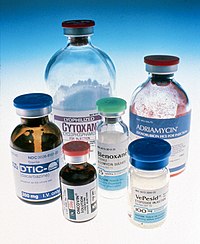History of cancer chemotherapy

Okay kiddo, cancer chemotherapy is a treatment that helps to kill cancer cells in someone’s body. It's been around for a long time, more than 50 years actually, and it's constantly improving.
Back in the 1940s, doctors noticed that soldiers who had been exposed to mustard gas during World War I had fewer white blood cells after the exposure. They realized that this chemical could potentially be used to treat cancer. Researchers started experimenting with different chemicals to see if they could kill cancer cells, and some drugs were found to work against leukemia, a type of blood cancer.
Fast forward to the 1960s, and scientists discovered a drug called methotrexate that could be used to treat another type of cancer called lymphoma. This was a big development in the history of chemotherapy because it showed that chemotherapy could be effective against different types of cancer.
As time went on, more and more chemotherapy drugs were developed. Some of the most common ones today include Taxol, Adriamycin, and cisplatin. These drugs work by targeting cells that divide quickly, which is what cancer cells do. The drugs either stop the cells from dividing or cause them to die.
One of the challenges with chemotherapy is that it’s not only killing cancer cells, but it can also harm healthy cells. That's why patients often experience side effects like hair loss, nausea, and fatigue. However, scientists are always trying to find ways to make chemotherapy more effective while minimizing these side effects.
Overall, cancer chemotherapy has come a long way since its early beginnings. It continues to be an important tool in the fight against cancer, helping many people to live longer and healthier lives.
Back in the 1940s, doctors noticed that soldiers who had been exposed to mustard gas during World War I had fewer white blood cells after the exposure. They realized that this chemical could potentially be used to treat cancer. Researchers started experimenting with different chemicals to see if they could kill cancer cells, and some drugs were found to work against leukemia, a type of blood cancer.
Fast forward to the 1960s, and scientists discovered a drug called methotrexate that could be used to treat another type of cancer called lymphoma. This was a big development in the history of chemotherapy because it showed that chemotherapy could be effective against different types of cancer.
As time went on, more and more chemotherapy drugs were developed. Some of the most common ones today include Taxol, Adriamycin, and cisplatin. These drugs work by targeting cells that divide quickly, which is what cancer cells do. The drugs either stop the cells from dividing or cause them to die.
One of the challenges with chemotherapy is that it’s not only killing cancer cells, but it can also harm healthy cells. That's why patients often experience side effects like hair loss, nausea, and fatigue. However, scientists are always trying to find ways to make chemotherapy more effective while minimizing these side effects.
Overall, cancer chemotherapy has come a long way since its early beginnings. It continues to be an important tool in the fight against cancer, helping many people to live longer and healthier lives.
Related topics others have asked about:
